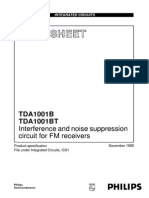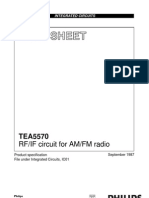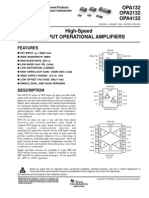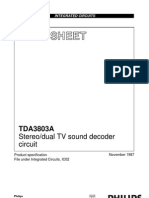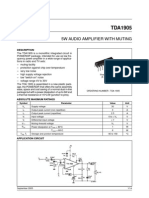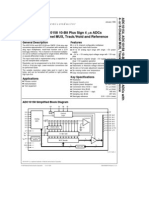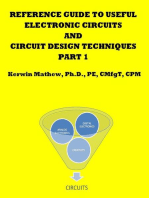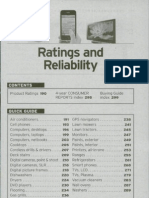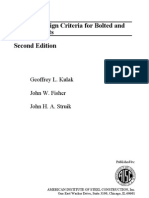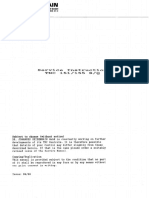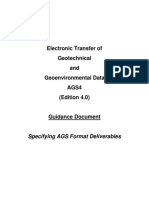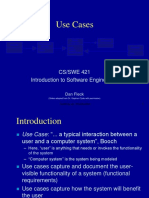Tda 1526
Tda 1526
Uploaded by
Adilcio MeloCopyright:
Available Formats
Tda 1526
Tda 1526
Uploaded by
Adilcio MeloCopyright
Available Formats
Share this document
Did you find this document useful?
Is this content inappropriate?
Copyright:
Available Formats
Tda 1526
Tda 1526
Uploaded by
Adilcio MeloCopyright:
Available Formats
INTEGRATED CIRCUITS
DATA SHEET
TDA1526 Stereo-tone/volume control circuit
Product specication File under Integrated Circuits, IC01 May 1992
Philips Semiconductors
Product specication
Stereo-tone/volume control circuit
GENERAL DESCRIPTION The device is designed as an active stereo-tone/volume control for car radios, TV receivers and mains-fed equipment. It includes functions for bass and treble control, volume control with built-in contour (can be switched off) and balance. All these functions can be controlled by DC voltages or by single linear potentiometers. QUICK REFERENCE DATA PARAMETER Supply voltage (pin 3) Supply current (pin 3) Signal handling with DC feedback Input signal handling (RMS value) Output signal handling (RMS value) Control range Maximum gain of volume Volume control range Balance control range Bass control range Treble control range Total harmonic distortion Noise performance Output noise voltage (unweighted) at f = 20 Hz to 20 kHz for Gv = 16 dB Signal processing Channel separation at Gv = 20 to 21.5 dB Tracking between channels for Gv = 21.5 to 26 dB Ripple rejection Operating ambient temperature range For explanation of notes see Notes to the characteristics. PACKAGE OUTLINE: 18-lead DIL; plastic (SOT102); SOT102-1; 1996 August 06. VP(rms) = 200 mV; f = 100 Hz; Gv = 0 dB RR Tamb 35 30 50 f = 250 Hz to 10 kHz f = 250 Hz to 6.3 kHz; balance at Gv = 10 dB Gv cs 46 60 RMS value; note 4 note 5 Vno(rms) 100 VP = 12 V see Fig.4 Gv max/Gv min Gv = 0 dB; see Fig.5 at 40 Hz; see Fig.6 at 16 kHz; see Fig.7 Gv max Gv Gv Gv Gv THD 20.5 90 21.5 100 40 19 to +17 3 15 3 notes 2 and 3 VP = 12 V VP = 8.5 to 15 V; THD = 0.7%; f = 1 kHz Vi(rms) Vo(rms) 1.8 1.8 2.0 2.0 CONDITIONS SYMBOL VP IP MIN. 7.5 25 TYP. 12 35 Features Few external components necessary Low noise due to internal gain
TDA1526
Bass emphasis can be increased by a double-pole low-pass filter Wide power supply voltage range.
MAX. 16.5 45
UNIT V mA
V V
23 0.5
dB dB dB dB dB %
200
dB
2.5 + 85
dB dB C
May 1992
May 1992
Philips Semiconductors
Stereo-tone/volume control circuit
3 Product specication
(1) Series resistor is recommended in the event of the capacitive loads exceeding 200 pF.
TDA1526
Fig.1 Block diagram and application circuit with single-pole filter.
Philips Semiconductors
Product specication
Stereo-tone/volume control circuit
TDA1526
Fig.2 Double-pole low-pass filter for improved bass-boost.
RATINGS Limiting values in accordance with the Absolute Maximum System (IEC 134) PARAMETER Supply voltage (pin 3) Total power dissipation Storage temperature range Operating ambient temperature range SYMBOL VP Ptot Tstg Tamb 55 30 MIN. MAX. 20 1200 + 150 + 80 UNIT V mW C C
May 1992
Philips Semiconductors
Product specication
Stereo-tone/volume control circuit
TDA1526
DC CHARACTERISTICS VP = V3-18 = 12 V; Tamb = 25 C; measured in Fig.1; RG 600 ; RL 4.7 k; CL 200 pF; unless otherwise specied PARAMETER Supply (pin 3) Supply voltage Supply current at VP = 8.5 V at VP = 12 V at VP = 15 V DC input levels (pins 4 and 15) at VP = 8.5 V at VP = 12 V at VP = 15 V DC output levels (pins 8 and 11) under all control voltage conditions with DC feedback at VP = 8.5 V at VP = 12 V at VP = 15 V Pin 17 Internal potentiometer supply voltage at VP = 8.5 V Contour on/off switch (control by I17) contour (switch open) linear (switch closed) Application without internal potentiometer supply voltage at VP 10.8 V (contour cannot be switched off) Voltage range forced to pin 17 DC control voltage range for volume, bass, treble and balance (pins 1, 9, 10 and 16 respectively) at V17-18 = 5 V using internal supply Input current of control inputs (pins 1, 9, 10 and 16) I1,9,10,16 5 A V1,9,10,16 V1,9,10,16 1.0 0.25 4.25 3.8 V V V17-18 4.5 VP/2VBE V I17 I17 1.5 0.5 10 mA mA V17-18 3.5 3.75 4.0 V V8, 11-18 V8, 11-18 V8, 11-18 3.3 4.6 5.7 4.25 6.0 7.5 5.2 7.4 9.3 V V V V4, 15-18 V4, 15-18 V4, 15-18 3.8 5.3 6.5 4.25 5.9 7.3 4.7 6.6 8.2 V V V IP = I3 IP = I3 IP = I3 19 25 30 27 35 43 35 45 56 mA mA mA VP = V3-18 7.5 16.5 V SYMBOL MIN. TYP. MAX. UNIT
May 1992
Philips Semiconductors
Product specication
Stereo-tone/volume control circuit
TDA1526
AC CHARACTERISTICS VP = V3-18 = 8.5 V; Tamb = 25 C; measured in Fig.1; contour switch closed (linear position); volume, balance, bass, and treble controls in mid-position; RG 600 ; RL 4.7 k; CL 200 pF; f = 1 kHz; unless otherwise specied PARAMETER Control range Maximum gain of volume (Fig.4) Volume control range; Gv max/Gv min Balance control range; Gv = 0 dB (Fig.5) Bass control range at 40 Hz (Fig.6) Treble control range at 16 kHz (Fig.7) Contour characteristics Signal inputs, outputs Input resistance; pins 4 and 15 (note 1) at gain of volume control: Gv = 20 dB Gv = 40 dB Output resistance (pins 8 and 11) Signal processing Power supply ripple rejection at VP(rms) 200 mV; f = 100 Hz; Gv = 0 dB Channel separation (250 Hz to 10 kHz) at Gv = 20 to + 21.5 dB Spread of volume control with constant control voltage V1-18 = 0.5 V17-18 Gain tolerance between left and right channel V16-18 = V1-18 = 0.5 V17-18 Tracking between channels for Gv = 21.5 to 26 dB f = 250 Hz to 6.3 kHz; balance adjusted at Gv = 10 dB Signal handling with DC feedback Input signal handling at VP = 8.5 V 15 V; THD = 0.7%; f = 1 kHz (RMS value) Output signal handling (note 2 and note 3) at VP = 8.5 V; THD = 0.7%; f = 1 kHz (RMS value) Noise performance (VP = 12 V) Output noise voltage (unweighted; Fig.14) at f = 20 Hz to 20 kHz (RMS value; note 4) for Gv = 16 dB (note 5) Vno(rms) 100 200 V Vo(rms) 1.8 2.0 V Vi(rms) 1.8 2.0 V Gv 2.5 dB Gv, L-R 1.5 dB Gv 3 dB cs 46 60 dB RR 35 50 dB Ri4, 15 Ri4, 15 Ro8, 11 10 160 300 k k Gv max Gv Gv Gv Gv 20.5 90 21.5 100 40 15 3 23 dB dB dB dB dB SYMBOL MIN. TYP. MAX. UNIT
19 to + 17 3 see Figs 9 and 10
May 1992
Philips Semiconductors
Product specication
Stereo-tone/volume control circuit
Notes to the characteristics 1. Equation for input resistance (see also Fig.3) 160 k R i = ------------------- ; G v max = 12. 1 + Gv
TDA1526
2. Frequencies below 200 Hz and above 5 kHz have reduced voltage swing, the reduction at 40 Hz and 16 kHz is 30%. 3. In the event of bass boosting the output signal handling is reduced. The reduction is 1 dB for maximum bass boost. 4. For peak values add 4.5 dB to RMS values. 5. Linear frequency response.
Fig.3 Input resistance (Ri) as a function of gain of volume control (Gv). Measured in Fig.1.
May 1992
Philips Semiconductors
Product specication
Stereo-tone/volume control circuit
TDA1526
Fig.4
Volume control curve; voltage gain (Gv) as a function of control voltage (V1-18). Measured in Fig.1 (internal potentiometer supply from pin 17 used); VP = 8.5 V; f = 1 kHz.
Fig.5
Balance control curve; voltage gain (Gv) as a function of control voltage (V16-18). Measured in Fig.1 (internal potentiometer supply from pin 17 used); VP = 8.5 V.
Fig.6
Bass control curve; voltage gain (Gv) as a function of control voltage (V9-18). Measured in Fig.1 with single-pole filter (internal potentiometer supply from pin 17 used); VP = 8.5 V; f = 40 Hz.
Fig.7
Treble control curve; voltage gain (Gv) as a function of control voltage (V10-18). Measured in Fig.1 (internal potentiometer supply from pin 17 used); VP = 8.5 V; f = 16 kHz.
May 1992
Philips Semiconductors
Product specication
Stereo-tone/volume control circuit
TDA1526
Fig.8
Contour frequency response curves; voltage gain (Gv) as a function of audio input frequency. Measured in Fig.1 with single-pole filter; VP = 8.5 V.
Fig.9
Contour frequency response curves; voltage gain (Gv) as a function of audio input frequency. Measured in Fig.1 with double-pole filter; VP = 8.5 V.
May 1992
Philips Semiconductors
Product specication
Stereo-tone/volume control circuit
TDA1526
Fig.10 Tone control frequency response curves; voltage gain (Gv) as a function of audio input frequency. Measured in Fig.1 with single-pole filter; VP = 8.5 V.
Fig.11 Tone control frequency response curves; voltage gain (Gv) as a function of audio input frequency. Measured in Fig.1 with double-pole filter; VP = 8.5 V.
May 1992
10
Philips Semiconductors
Product specication
Stereo-tone/volume control circuit
TDA1526
Fig.12 Total harmonic distortion (THD); as a function of audio input frequency. Measured in Fig.1; VP = 8.5 V; volume control voltage gain at Vo G v = 20 log ------- = 0dB Vi
Fig.13 Total harmonic distortion (THD); as a function of output voltage (Vo). Measured in Fig.1; VP = 8.5 V; fi = 1 kHz.
May 1992
11
Philips Semiconductors
Product specication
Stereo-tone/volume control circuit
TDA1526
Fig.14 Noise output voltage (Vno(rms); unweighted); as a function of voltage gain (Gv). Measured in Fig.1; VP = 15 V; f = 20 Hz to 20 kHz.
May 1992
12
Philips Semiconductors
Product specication
Stereo-tone/volume control circuit
PACKAGE OUTLINE DIP18: plastic dual in-line package; 18 leads (300 mil)
TDA1526
SOT102-1
D seating plane
ME
A2
A1
c Z e b1 b 18 10 b2 MH w M (e 1)
pin 1 index E
5 scale
10 mm
DIMENSIONS (inch dimensions are derived from the original mm dimensions) UNIT mm inches A max. 4.7 0.19 A1 min. 0.51 0.020 A2 max. 3.7 0.15 b 1.40 1.14 0.055 0.044 b1 0.53 0.38 0.021 0.015 b2 1.40 1.14 0.055 0.044 c 0.32 0.23 0.013 0.009 D (1) 21.8 21.4 0.86 0.84 E (1) 6.48 6.20 0.26 0.24 e 2.54 0.10 e1 7.62 0.30 L 3.9 3.4 0.15 0.13 ME 8.25 7.80 0.32 0.31 MH 9.5 8.3 0.37 0.33 w 0.254 0.01 Z (1) max. 0.85 0.033
Note 1. Plastic or metal protrusions of 0.25 mm maximum per side are not included. OUTLINE VERSION SOT102-1 REFERENCES IEC JEDEC EIAJ EUROPEAN PROJECTION
ISSUE DATE 93-10-14 95-01-23
May 1992
13
Philips Semiconductors
Product specication
Stereo-tone/volume control circuit
SOLDERING Introduction There is no soldering method that is ideal for all IC packages. Wave soldering is often preferred when through-hole and surface mounted components are mixed on one printed-circuit board. However, wave soldering is not always suitable for surface mounted ICs, or for printed-circuits with high population densities. In these situations reflow soldering is often used. This text gives a very brief insight to a complex technology. A more in-depth account of soldering ICs can be found in our IC Package Databook (order code 9398 652 90011). Soldering by dipping or by wave The maximum permissible temperature of the solder is 260 C; solder at this temperature must not be in contact with the joint for more than 5 seconds. The total contact time of successive solder waves must not exceed 5 seconds. DEFINITIONS Data sheet status Objective specication Preliminary specication Product specication Limiting values
TDA1526
The device may be mounted up to the seating plane, but the temperature of the plastic body must not exceed the specified maximum storage temperature (Tstg max). If the printed-circuit board has been pre-heated, forced cooling may be necessary immediately after soldering to keep the temperature within the permissible limit. Repairing soldered joints Apply a low voltage soldering iron (less than 24 V) to the lead(s) of the package, below the seating plane or not more than 2 mm above it. If the temperature of the soldering iron bit is less than 300 C it may remain in contact for up to 10 seconds. If the bit temperature is between 300 and 400 C, contact may be up to 5 seconds.
This data sheet contains target or goal specications for product development. This data sheet contains preliminary data; supplementary data may be published later. This data sheet contains nal product specications.
Limiting values given are in accordance with the Absolute Maximum Rating System (IEC 134). Stress above one or more of the limiting values may cause permanent damage to the device. These are stress ratings only and operation of the device at these or at any other conditions above those given in the Characteristics sections of the specication is not implied. Exposure to limiting values for extended periods may affect device reliability. Application information Where application information is given, it is advisory and does not form part of the specication. LIFE SUPPORT APPLICATIONS These products are not designed for use in life support appliances, devices, or systems where malfunction of these products can reasonably be expected to result in personal injury. Philips customers using or selling these products for use in such applications do so at their own risk and agree to fully indemnify Philips for any damages resulting from such improper use or sale.
May 1992
14
This datasheet has been download from: www.datasheetcatalog.com Datasheets for electronics components.
You might also like
- Unicam ManualDocument105 pagesUnicam ManualArif AnuarNo ratings yet
- TDA1576Document16 pagesTDA1576cgmannerheimNo ratings yet
- Tda 5731Document17 pagesTda 5731malirezazadeh5549No ratings yet
- T.D.A 1524 PDFDocument16 pagesT.D.A 1524 PDFJose M PeresNo ratings yet
- Tda 1591Document20 pagesTda 1591Brzata PticaNo ratings yet
- Tda1526 PDFDocument15 pagesTda1526 PDFroger.No ratings yet
- Tda1029 PDFDocument16 pagesTda1029 PDFromanbunNo ratings yet
- TDA7440D: Tone Control Digitally Controlled Audio ProcessorDocument17 pagesTDA7440D: Tone Control Digitally Controlled Audio ProcessorJimmy R. Calderon GualeNo ratings yet
- ReceiverDocument20 pagesReceiverEe Ling ChowNo ratings yet
- That1510p PDFDocument6 pagesThat1510p PDFJefferson Gutama ValladaresNo ratings yet
- Data Sheet: Multistandard VIF-PLL DemodulatorDocument21 pagesData Sheet: Multistandard VIF-PLL Demodulatorjakalae5263No ratings yet
- Tda 2595Document13 pagesTda 2595beta2009No ratings yet
- Data Sheet: TDA1001B TDA1001BTDocument14 pagesData Sheet: TDA1001B TDA1001BTconti51No ratings yet
- Tda 7438Document18 pagesTda 7438sontuyet82No ratings yet
- 3 V To 5 V Single Supply, 200 KSPS 8-Channel, 12-Bit Sampling ADC AD7858/AD7858LDocument32 pages3 V To 5 V Single Supply, 200 KSPS 8-Channel, 12-Bit Sampling ADC AD7858/AD7858LJodelCamarinNo ratings yet
- Lm1205/Lm1207 130 Mhz/85 MHZ RGB Video Amplifier System With BlankingDocument24 pagesLm1205/Lm1207 130 Mhz/85 MHZ RGB Video Amplifier System With BlankingedgarlibanioNo ratings yet
- Max Power 43 W BTL × 4 CH Audio Power IC: FeaturesDocument12 pagesMax Power 43 W BTL × 4 CH Audio Power IC: FeaturesMiloud ChouguiNo ratings yet
- Tda 7313Document14 pagesTda 7313ClaudiuMaxmiucNo ratings yet
- Tda 7440Document17 pagesTda 7440Albert ThomasNo ratings yet
- In A 217Document14 pagesIn A 217balaji_viswaNo ratings yet
- Tda 2005Document20 pagesTda 2005Cris VMNo ratings yet
- Tda 6103Document16 pagesTda 6103Ondrej LomjanskiNo ratings yet
- Tda 8780Document16 pagesTda 8780Andrey DolgovNo ratings yet
- Data Sheet: TDA1558QDocument11 pagesData Sheet: TDA1558QMarco Tulio Da SilvaNo ratings yet
- Monitor Amplifier: DescriptionDocument17 pagesMonitor Amplifier: DescriptionGiapy Phuc TranNo ratings yet
- Tda 2005Document21 pagesTda 2005Vamsi Mani Deep ElapakurtyNo ratings yet
- 3 V To 5 V Single Supply, 200 KSPS 8-Channel, 12-Bit Sampling ADC AD7858/AD7858LDocument36 pages3 V To 5 V Single Supply, 200 KSPS 8-Channel, 12-Bit Sampling ADC AD7858/AD7858Ljnax101No ratings yet
- Tda 7439Document17 pagesTda 7439Arwana ChipmunksNo ratings yet
- 1395Document14 pages1395Aurel-LucianNedaNo ratings yet
- Hoja de Datos Del TDA 7439Document20 pagesHoja de Datos Del TDA 7439_el_patriarca_No ratings yet
- Tea5570 Philips Data SheetDocument19 pagesTea5570 Philips Data Sheetarizona976No ratings yet
- Opa 2132Document18 pagesOpa 2132Shree RaamNo ratings yet
- TA2020Document13 pagesTA2020Irimia Mihai AdrianNo ratings yet
- Cxa1695l PDFDocument11 pagesCxa1695l PDFperro sNo ratings yet
- Programmable Quad Bipolar Operational Amplifier: LM146 LM246 LM346Document6 pagesProgrammable Quad Bipolar Operational Amplifier: LM146 LM246 LM346Alejandro Borrego DominguezNo ratings yet
- Tda 7468DDocument22 pagesTda 7468DJohn Keneth Vasquez100% (1)
- Datasheet Ina217Document15 pagesDatasheet Ina217Ada Dev CsabaNo ratings yet
- BF244CDocument6 pagesBF244CJhelson CondeNo ratings yet
- TDA 1519cDocument21 pagesTDA 1519cCris VMNo ratings yet
- Tda 3803Document11 pagesTda 3803Alan LópezNo ratings yet
- UV 1316 Tuner Phil Sharp TVDocument20 pagesUV 1316 Tuner Phil Sharp TVvujsNo ratings yet
- AN148Document10 pagesAN148Sherwin CruzNo ratings yet
- 4937 DI5 3x8899 2Document17 pages4937 DI5 3x8899 2CdeKoninghNo ratings yet
- LB1980 DatasheetDocument6 pagesLB1980 DatasheetMetalloyNo ratings yet
- Dual High Slew Rate, Low Noise Operational Amplifier: BA15218 / BA15218F / BA15218NDocument5 pagesDual High Slew Rate, Low Noise Operational Amplifier: BA15218 / BA15218F / BA15218NAnonymous vKD3FG6RkNo ratings yet
- 5W Audio Amplifier With Muting: DescriptionDocument14 pages5W Audio Amplifier With Muting: DescriptionEdgar Angel MamaniNo ratings yet
- 3 V/5 V, 1 MW 2-/3-Channel 16-Bit, Sigma-Delta Adcs: A MaxDocument32 pages3 V/5 V, 1 MW 2-/3-Channel 16-Bit, Sigma-Delta Adcs: A Maxmeroka2000No ratings yet
- Adc 10158Document26 pagesAdc 10158Felipe LorenziNo ratings yet
- MCP6N11 Instrumentation AmplifierDocument50 pagesMCP6N11 Instrumentation AmplifierNeneFINo ratings yet
- TDA1072ADocument20 pagesTDA1072AUbiracy ZanetiNo ratings yet
- LM359 Dual, High Speed, Programmable, Current Mode (Norton) AmplifiersDocument24 pagesLM359 Dual, High Speed, Programmable, Current Mode (Norton) Amplifierswilliamjamir2295No ratings yet
- BLF8G20LS 200VDocument14 pagesBLF8G20LS 200VNarasimha SunchuNo ratings yet
- Tda 2595Document12 pagesTda 2595bolopo2No ratings yet
- Reference Guide To Useful Electronic Circuits And Circuit Design Techniques - Part 2From EverandReference Guide To Useful Electronic Circuits And Circuit Design Techniques - Part 2No ratings yet
- Reference Guide To Useful Electronic Circuits And Circuit Design Techniques - Part 1From EverandReference Guide To Useful Electronic Circuits And Circuit Design Techniques - Part 1Rating: 2.5 out of 5 stars2.5/5 (3)
- Modelsim TutorialDocument26 pagesModelsim Tutorialsachinshetty001No ratings yet
- Automation Component - Mechanical Fast - Handbook PDFDocument782 pagesAutomation Component - Mechanical Fast - Handbook PDFfsilassie8012No ratings yet
- KVM PDFDocument37 pagesKVM PDFinvarNo ratings yet
- Linear Continuous Wave (CW) Modulation: August 2013 Lectured by Assoc Prof. Thuong Le-TienDocument40 pagesLinear Continuous Wave (CW) Modulation: August 2013 Lectured by Assoc Prof. Thuong Le-TienThanh TùngNo ratings yet
- Gearbox - Eaton 4106, 5206 (En)Document94 pagesGearbox - Eaton 4106, 5206 (En)blablabla5780% (1)
- Syp 029048Document20 pagesSyp 029048testNo ratings yet
- Web Cast of PowershellDocument37 pagesWeb Cast of Powershellsdhanesh84No ratings yet
- FST4 10 enDocument14 pagesFST4 10 enJvr VelascoNo ratings yet
- Consumer Reports BuyingGuide 2010 - All Product RatingsDocument107 pagesConsumer Reports BuyingGuide 2010 - All Product Ratingsdesijnk100% (2)
- Caterpillar Excabadora 246d Diagrama HydraDocument11 pagesCaterpillar Excabadora 246d Diagrama Hydrahitler morales gavidia100% (1)
- Guide To Design Criteria For Bolts and Riveted JointsDocument352 pagesGuide To Design Criteria For Bolts and Riveted JointsHomero Silva96% (24)
- 9691 s12 QP 13Document12 pages9691 s12 QP 13TrynosNo ratings yet
- ACON Automation System Technical Spec BDocument15 pagesACON Automation System Technical Spec BrazormebackNo ratings yet
- D-6225 Traunreut Tel. (08669) 31-O: Dr. Johannes Heidenhain GMBHDocument97 pagesD-6225 Traunreut Tel. (08669) 31-O: Dr. Johannes Heidenhain GMBHamir.suljic23-1No ratings yet
- English ASUS Update MyLogo2 3 v1.0 PDFDocument4 pagesEnglish ASUS Update MyLogo2 3 v1.0 PDFDani CangkalNo ratings yet
- Mainframe FeaturesDocument14 pagesMainframe Featuresapi-3736498No ratings yet
- XML 2Document64 pagesXML 2wawinNo ratings yet
- Liebert PSI: User Manual-1000/1500/2200/3000, 120VACDocument28 pagesLiebert PSI: User Manual-1000/1500/2200/3000, 120VACrodolfo barrientos mNo ratings yet
- PDFDocument3 pagesPDFShaili PalejkarNo ratings yet
- Datasheet PiccoloDocument177 pagesDatasheet PiccoloEric DilgerNo ratings yet
- Qualcastm2eb1637m Manual v1 20141020Document26 pagesQualcastm2eb1637m Manual v1 20141020Richard Moore0% (2)
- GD01 - Digital Data Specification - V0Document9 pagesGD01 - Digital Data Specification - V0zeiloNo ratings yet
- Trunks Maintenance Guide PDFDocument192 pagesTrunks Maintenance Guide PDFRandyNo ratings yet
- Use Case BasicUseCasesDocument16 pagesUse Case BasicUseCasessamiNo ratings yet
- Intel Pentium D Processor 900 Sequence and Intel Pentium Processor Extreme Edition 955, 965Document112 pagesIntel Pentium D Processor 900 Sequence and Intel Pentium Processor Extreme Edition 955, 965قناة تعدد في المحتوىNo ratings yet
- Compiler DesignDocument31 pagesCompiler DesignmadforbunnyNo ratings yet
- Agricultural Based Monitoring System With Android App Sms AlertDocument53 pagesAgricultural Based Monitoring System With Android App Sms AlertvinayakaNo ratings yet
- Mgate 4101-Mb-Pbs Quick Installation Guide: Reset ButtonDocument2 pagesMgate 4101-Mb-Pbs Quick Installation Guide: Reset ButtonDuy NguyễnNo ratings yet
- Synchronous Motors 1FK7: Operating Instructions 03/2011Document58 pagesSynchronous Motors 1FK7: Operating Instructions 03/2011Krittaphak HacheyramNo ratings yet












